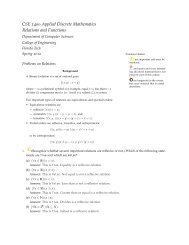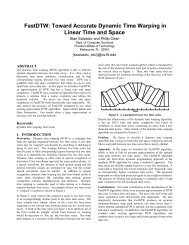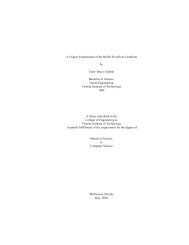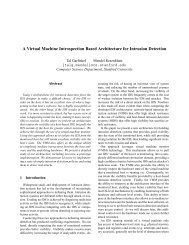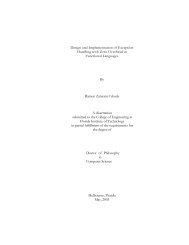Social Choice Theory and Recommender Systems ... - CiteSeerX
Social Choice Theory and Recommender Systems ... - CiteSeerX
Social Choice Theory and Recommender Systems ... - CiteSeerX
You also want an ePaper? Increase the reach of your titles
YUMPU automatically turns print PDFs into web optimized ePapers that Google loves.
One way to impose SI is to normalize all of the users’ratings to a common scale before applying f. One naturalnormalization is:u iR− min( u i R)u i R′←max u R − min u R( ) ( )This transforms all ratings to the [0,1] range, filtering outany dependence on multiplicative (α i) or additive (β i) scalefactors. 1Another way to ensure SI is to constrain f to dependonly on the relative rank among titles (the ordinalpreferences of users), <strong>and</strong> not on the magnitude of ratings.Freund et al. [1998] strongly advocate this approach.One important property of [the collaborativefiltering] problem is that the most relevantinformation to be combined represents relativepreferences rather than absolute ratings. In otherwords, even if the ranking of [titles] is expressed byassigning each [title] a numeric score, we would liketo ignore the absolute values of these scores <strong>and</strong>concentrate only on their relative order.By ignoring all but relative rank, Freund et al.’s algorithmsatisfies SI. On the other h<strong>and</strong>, the similarity-basedmethods violate it.Cohen et al. [1999] develop another algorithm forcombining ordinal preferences from multiple experts toform a composite ranking of items, applicable forcollaborative filtering. Their algorithm proceeds in twostages. The first stage actually satisfies all four propertiesdefined in this section: UNIV, UNAM, SI <strong>and</strong> IIA. As aresult, the first-stage preference relation may containcycles (e.g., title j is preferred to title k, k is preferred to l,<strong>and</strong> l is preferred to j). The second stage of their algorithmattempts to find the acyclic preference function that mostclosely approximates the stage one preference relation. Thecomplete two-stage algorithm retains invariance to scale(satisfies SI), but may depend on irrelevant alternatives(violates IIA).Different researchers favor one or the other of these fourproperties; the following proposition shows that only onevery restrictive CF function obeys them all.Proposition 1 (Nearest neighbor). Assuming that|NR| > 2, then the only function f of the form (1) thatsatisfies UNIV, UNAM, IIA, <strong>and</strong> SI is such that:R ij> R ik⇒ P aj> P ak,for all titles j,k ∈ NR, <strong>and</strong> for one distinguished user i. Thechoice of user i can depend on the ratings{R⋅t j: j ∈ T-NR}, as long as this dependence is invariant toscale, but once the “best” i is determined, his or her ratings1 If max(u i ⋅R) = min(u i ⋅R), then set u i ⋅R′ = 0.iifor the titles in NR must be fully adopted as the activeuser’s predicted ratings.Proof (sketch): Let j be a title in NR. Rewrite f in equation(1) in the following, equivalent, form:P aj= f({R⋅t j: j ∈ T-NR}, { R⋅t j: j ∈ NR})= g({R⋅t j: j ∈ NR}) ,where the choice of function g is itself allowed to dependon {R⋅t j: j ∈ T-NR}. With the exception of the “no rating”value ⊥, the problem has been cast into the same terms asin the <strong>Social</strong> <strong>Choice</strong> literature. Doyle <strong>and</strong> Wellman [1991]point out that Arrow’s original proof does not require thatall users’ preference orderings be complete, <strong>and</strong> the proofinsists that the aggregate ordering is complete only foritems that some user has expressed a preference over. Withthe additional assumption of minimal functionality (part ofthe definition of UNIV), similar to Doyle <strong>and</strong> Wellman’s“conflict resolution” condition, st<strong>and</strong>ard social choiceproofs become applicable. It follows, from Sen’s [1986] orRobert’s [1980] extension of Arrow’s theorem [1963], thatg, <strong>and</strong> therefore f, must be of the nearest neighbor formspecified. •If the dictatorial user i does not express a rating for sometitles, then there exists a secondary dictator h whosepreferences are fully adopted among those titles unrated byi <strong>and</strong> rated by h. This “cascade of dictators” continues untilthe minimal functionality clause of UNIV is satisfied, asshown in Doyle <strong>and</strong> Wellman’s [1991] axiomatic treatmentof default logic.Weighted Average CollaborativeFilteringWe now examine a slight weakening of the set ofproperties leading to Proposition 1. Under these newconditions, we find that the only possible CF function is aweighted sum: The active user’s predicted rating for eachtitle is a weighted average of the other users’ ratings for thesame title. Our argument is again based on results from<strong>Social</strong> <strong>Choice</strong> theory; we largely follow Fishburn’s [1987]explication of work originally due to Roberts [1980].We replace the SI property with a weaker one:Property 4 ∗ (TI) Translation Invariance. Consider twoinput ratings matrices, R <strong>and</strong> R′, such that, for all users i,u i⋅R′ = α (u i⋅R) + β ifor any positive constant α, <strong>and</strong> anyconstants β i. Then P aj> P akif <strong>and</strong> only if P′ aj> P′ ak, for alltitles j,k ∈ NR.This condition requires that recommendations remainunchanged when all ratings are multiplied by the sameconstant, <strong>and</strong>/or when any of the individual ratings areshifted by additive constants. The TI property, like SI, stillhonors the belief that the absolute rating of one title by one



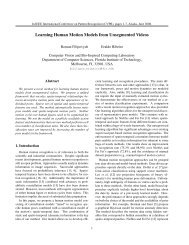

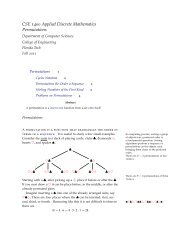
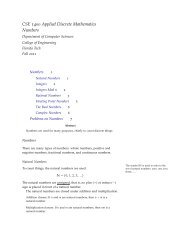
![{ public static void main (String[] args) { System.out.println (](https://img.yumpu.com/49719541/1/190x143/-public-static-void-main-string-args-systemoutprintln-hello-.jpg?quality=85)

